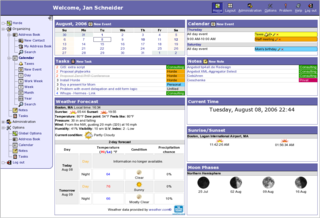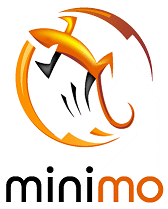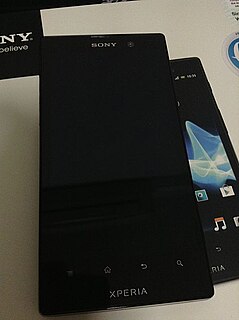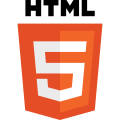Adobe Flash is a deprecated multimedia software platform used for production of animations, rich Internet applications, desktop applications, mobile applications, mobile games and embedded web browser video players. Flash displays text, vector graphics and raster graphics to provide animations, video games and applications. It allows streaming of audio and video, and can capture mouse, keyboard, microphone and camera input. Related development platform Adobe AIR continues to be supported.
An application server is a server that hosts applications.

A web application is an internet technology term used to describe a computer software program that is run on a web server, unlike computer-based software programs that are stored locally on the Operating System (OS) of a device. Web applications are accessed by the user through a web browser with an active internet connection. These applications are programmed using a client–server modeled structure—the user ("client") is provided services through an off-site serverthat is hosted by a third-party. Examples of commonly-used, web applications, include: web-mail, online retail sales, online banking, and online auctions.

A mobile device is a computer small enough to hold and operate in the hand. Typically, any handheld computer device will have an LCD or OLED flatscreen interface, providing a touchscreen interface with digital buttons and keyboard or physical buttons along with a physical keyboard. Many such devices can connect to the Internet and interconnect with other devices such as car entertainment systems or headsets via Wi-Fi, Bluetooth, cellular networks or near field communication (NFC). Integrated cameras, the ability to place and receive voice and video telephone calls, video games, and Global Positioning System (GPS) capabilities are common. Power is typically provided by a lithium battery. Mobile devices may run mobile operating systems that allow third-party apps specialized for said capabilities to be installed and run.
A rich web application is a web application that has many of the characteristics of desktop application software. The concept is closely related to a single-page application, and may allow the user interactive features such as drag and drop, background menu, WYSIWYG editing, etc. HTML5 is a current standard for delivering rich web applications, supported by all major browsers.

Minimo was a project to create a version of the Mozilla web browser for small devices like PDAs and mobile phones.

Wapedia was a mobile version of Wikipedia. It was started in August 2004 by Florian Amrhein and shut down on 4 November 2013. It was operated by Taptu.
Mobile app development is the act or process by which a mobile app is developed for mobile devices, such as personal digital assistants, enterprise digital assistants or mobile phones. These applications can be pre-installed on phones during manufacturing platforms, or delivered as web applications using server-side or client-side processing to provide an "application-like" experience within a Web browser. Application software developers also must consider a long array of screen sizes, hardware specifications, and configurations because of intense competition in mobile software and changes within each of the platforms. Mobile app development has been steadily growing, in revenues and jobs created. A 2013 analyst report estimates there are 529,000 direct app economy jobs within the EU then 28 members, 60 percent of which are mobile app developers.

The mobile web refers to browser-based World Wide Web services accessed from handheld mobile devices, such as smartphones or feature phones, through a mobile or other wireless network.

Adobe AIR is a cross-platform runtime system developed by Adobe Systems for building desktop applications and mobile applications, programmed using Adobe Animate, ActionScript and optionally Apache Flex. The runtime supports installable applications on Windows, OS X and mobile operating systems including Android, iOS and BlackBerry Tablet OS. It also originally ran on Linux, but support was discontinued as of version 2.6 in 2011.
Wireless Application Protocol (WAP) is a technical standard for accessing information over a mobile wireless network. A WAP browser is a web browser for mobile devices such as mobile phones that uses the protocol. Introduced in 1999, WAP achieved some popularity in the early 2000s, but by the 2010s it had been largely superseded by more modern standards. Most modern handset internet browsers now fully support HTML, so they do not need to use WAP markup for web page compatibility, and therefore, most are no longer able to render and display pages written in WML, WAP's markup language.

Apache Cordova is a mobile application development framework originally created by Nitobi. Adobe Systems purchased Nitobi in 2011, rebranded it as PhoneGap, and later released an open source version of the software called Apache Cordova. Apache Cordova enables software programmers to build applications for mobile devices using CSS3, HTML5, and JavaScript instead of relying on platform-specific APIs like those in Android, iOS, or Windows Phone. It enables wrapping up of CSS, HTML, and JavaScript code depending upon the platform of the device. It extends the features of HTML and JavaScript to work with the device. The resulting applications are hybrid, meaning that they are neither truly native mobile application nor purely Web-based. Mixing native and hybrid code snippets has been possible since version 1.9.
HTML5 File API aspect provides an API for representing file objects in web applications and programmatic selection and accessing their data. In addition, this specification defines objects to be used within threaded web applications for the synchronous reading of files. The File API describes how interactions with files are handled, for reading information about them and their data as well, to be able to upload it. Despite the name, the File API is not part of HTML5.

Sencha Touch is a user interface (UI) JavaScript library, or web framework, specifically built for the Mobile Web. It can be used by Web developers to develop user interfaces for mobile web applications that look and feel like native applications on supported mobile devices. It is based on web standards such as HTML5, CSS3 and JavaScript. The goal of Sencha Touch is to facilitate quick and easy development of HTML5 based mobile apps which run on Android, iOS, Windows, Tizen and BlackBerry devices, simultaneously allowing a native look and feel to the apps.

Firefox OS is a discontinued open-source operating system – made for smartphones, tablet computers and smart TVs – designed by Mozilla and external contributors. It is based on the rendering engine of the Firefox web browser, Gecko, and on the Linux kernel. It was first commercially released in 2013.
A mobile application, also referred to as a mobile app or simply an app, is a computer program or software application designed to run on a mobile device such as a phone, tablet, or watch. Apps were originally intended for productivity assistance such as email, calendar, and contact databases, but the public demand for apps caused rapid expansion into other areas such as mobile games, factory automation, GPS and location-based services, order-tracking, and ticket purchases, so that there are now millions of apps available. Apps are generally downloaded from application distribution platforms which are operated by the owner of the mobile operating system, such as the App Store (iOS) or Google Play Store. Some apps are free, and others have a price, with the profit being split between the application's creator and the distribution platform. Mobile applications often stand in contrast to desktop applications which are designed to run on desktop computers, and web applications which run in mobile web browsers rather than directly on the mobile device.

Sony Xperia Ion is an Android smartphone developed and manufactured by Sony Mobile Communications. It was launched at the 2012 Consumer Electronics Show with Sony Xperia S.

The Sony Xperia acro S is a dust- and water-resistant Android smartphone produced and developed by Sony Mobile Communications.
Adobe Edge is a suite of web development tools developed by Adobe Systems that enhances the capabilities of their other applications, such as Dreamweaver. The first application in the suite was released in August 2011 as a multimedia authoring tool designed to succeed the Flash platform. In September 2012, Adobe renamed the application Edge Animate, and announced Edge Reflow, Edge Code, and Edge Inspect. Also packaged with the suite are Edge Web Fonts, the PhoneGap application, and access to Adobe's Typekit service.
DaVinci is a development tool used to create HTML5 mobile applications and media content. It includes a jQuery framework, which is a JavaScript library, and can be used by developers and designers, to create web applications used on mobile devices, that have a user experience similar to native applications. Business applications, games, and rich media content, such as HTML5 multi-media magazines, advertisements, and animation, may be produced with the tool. DaVinci is based on standard web technology, including HTML5, CSS3, and JavaScript.











